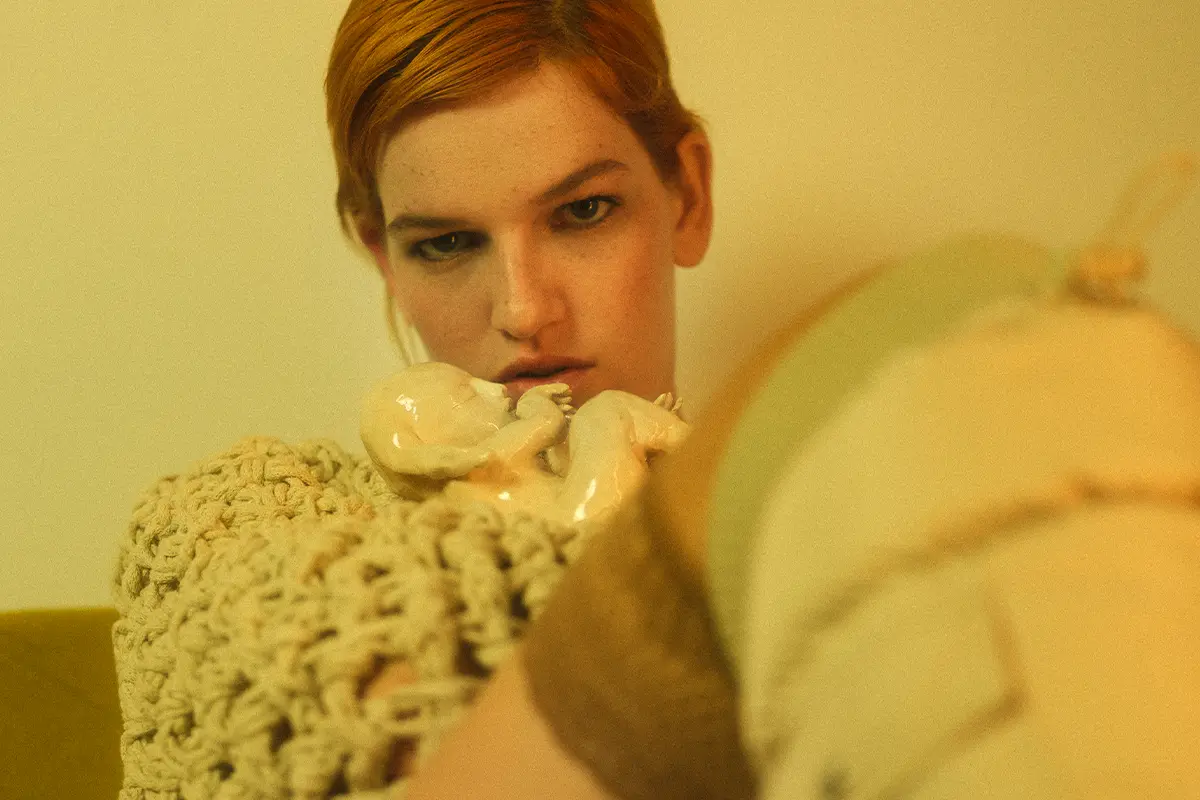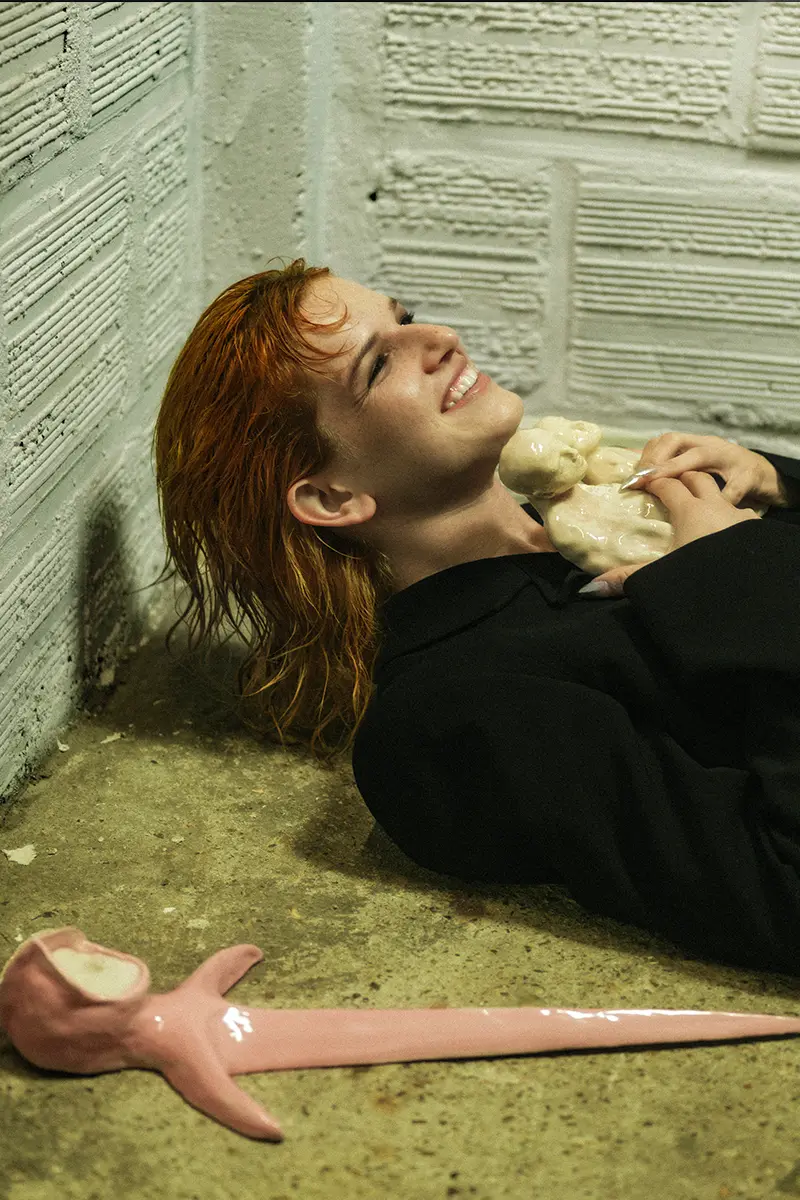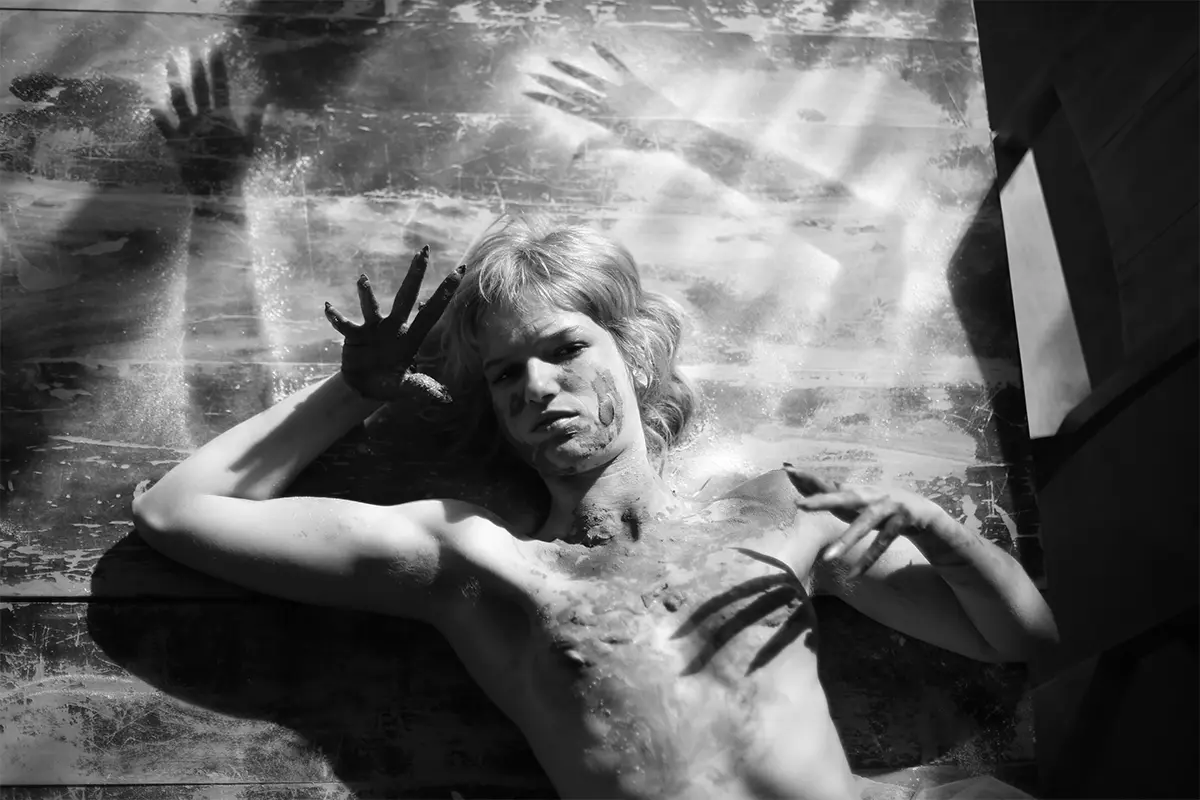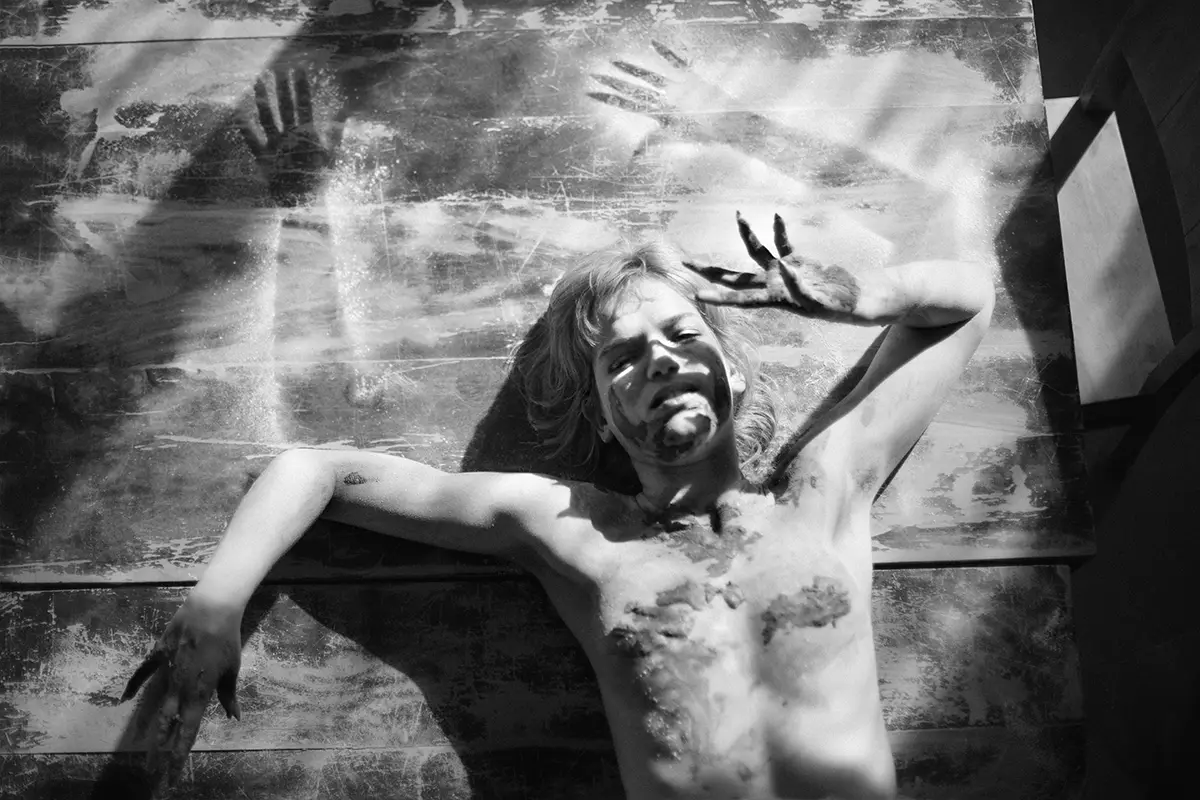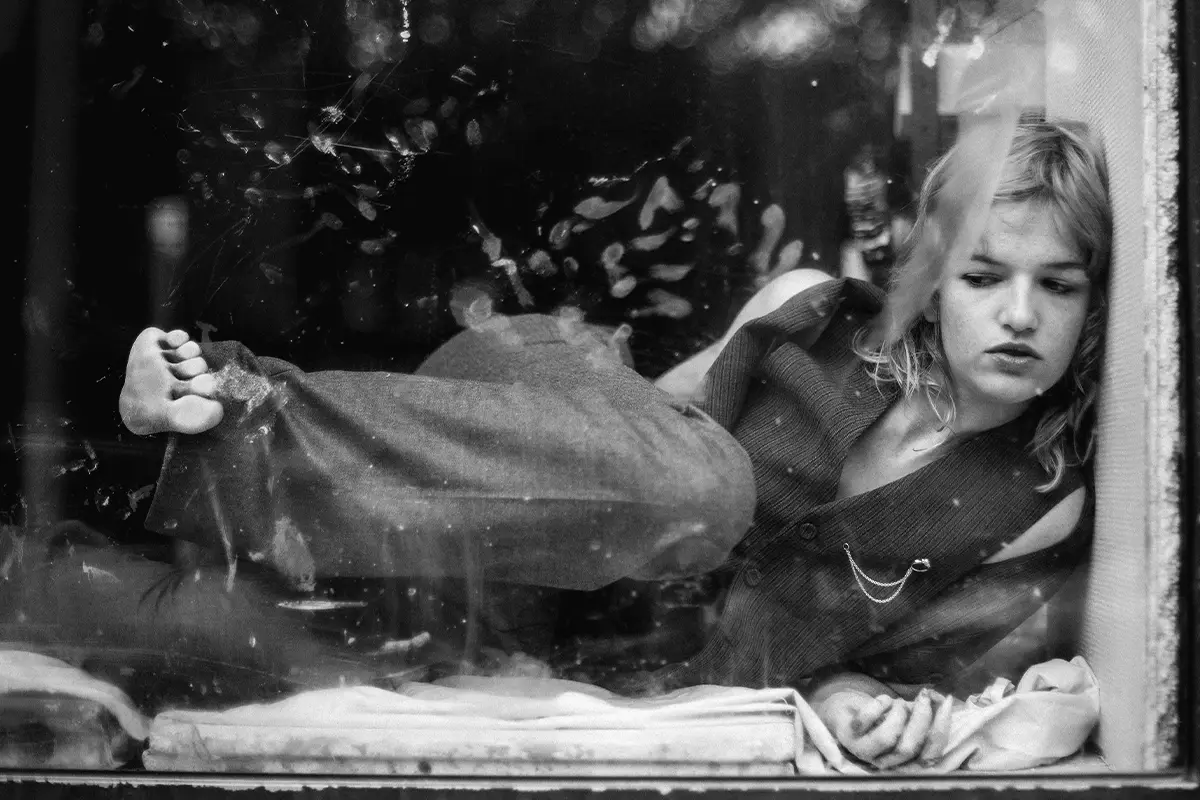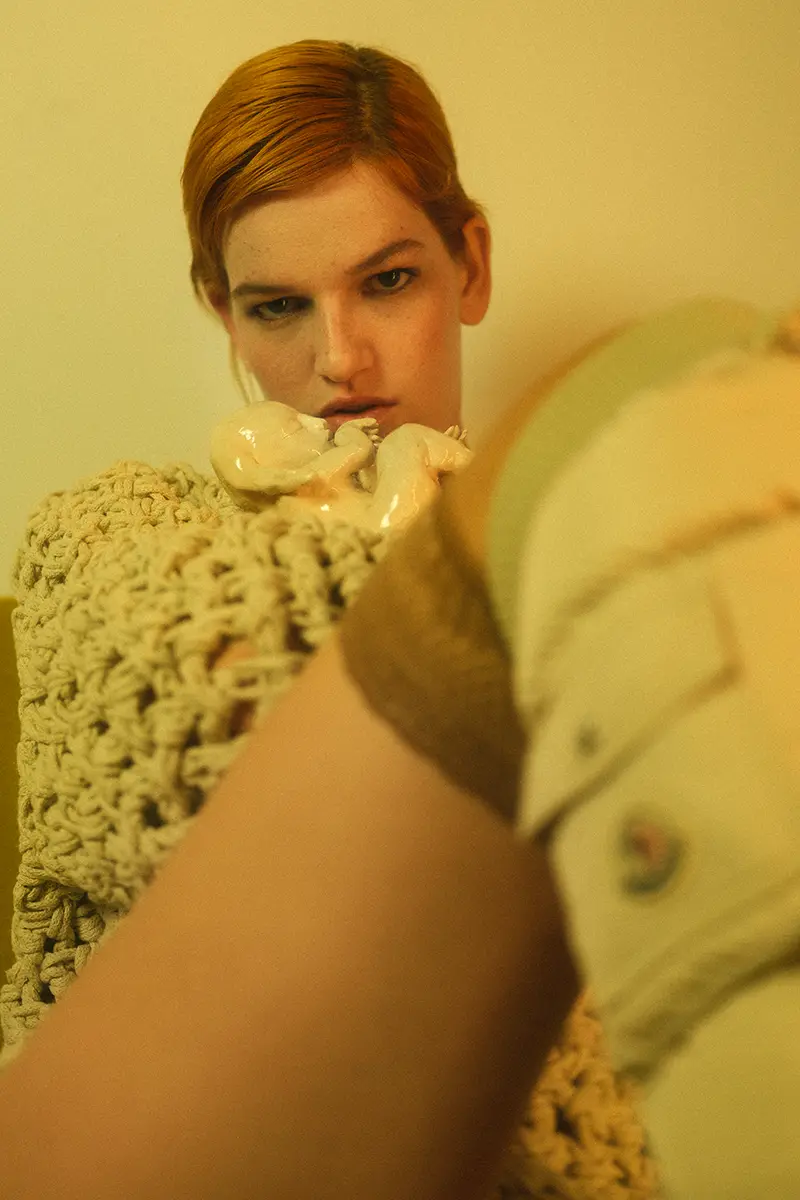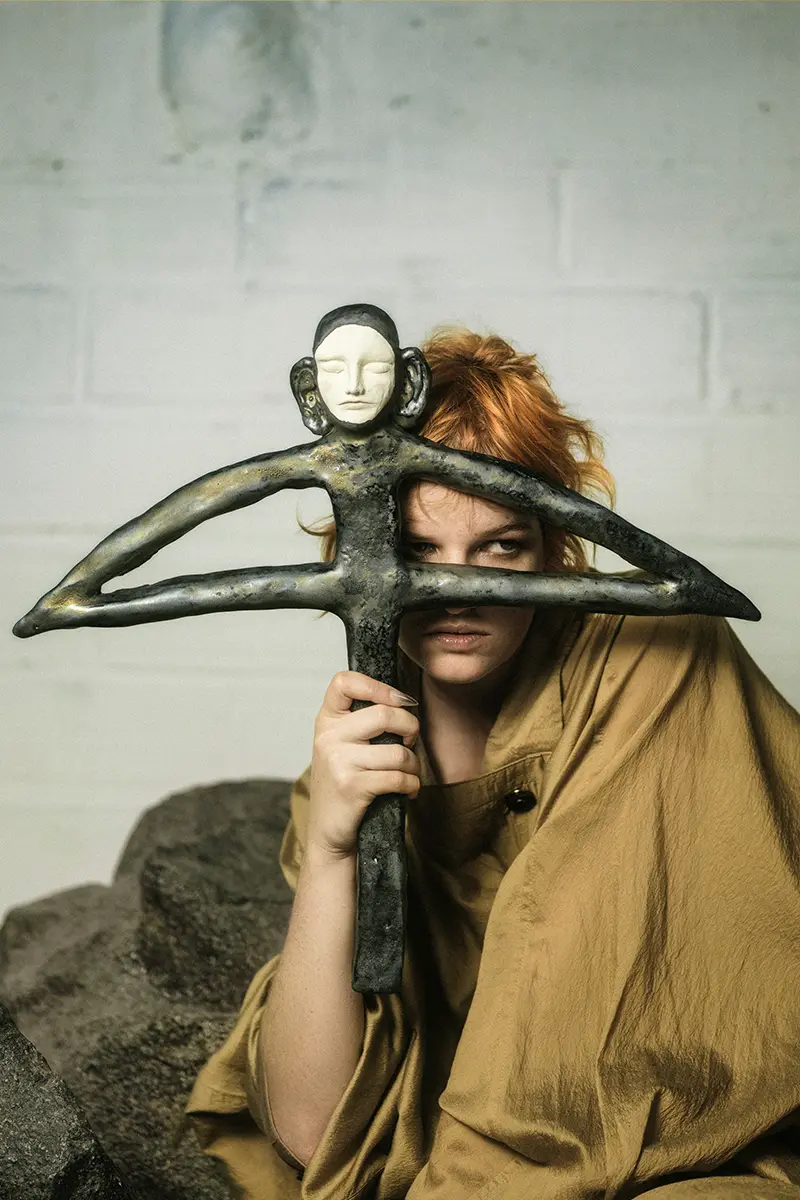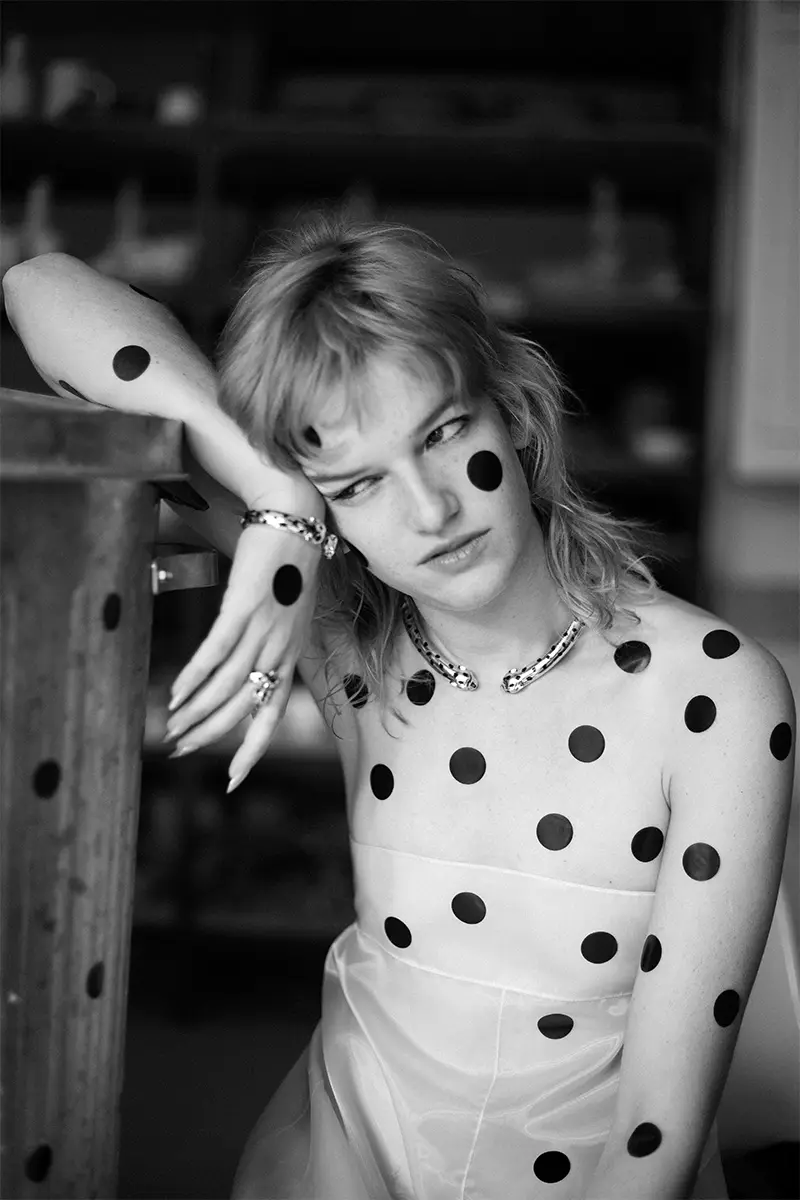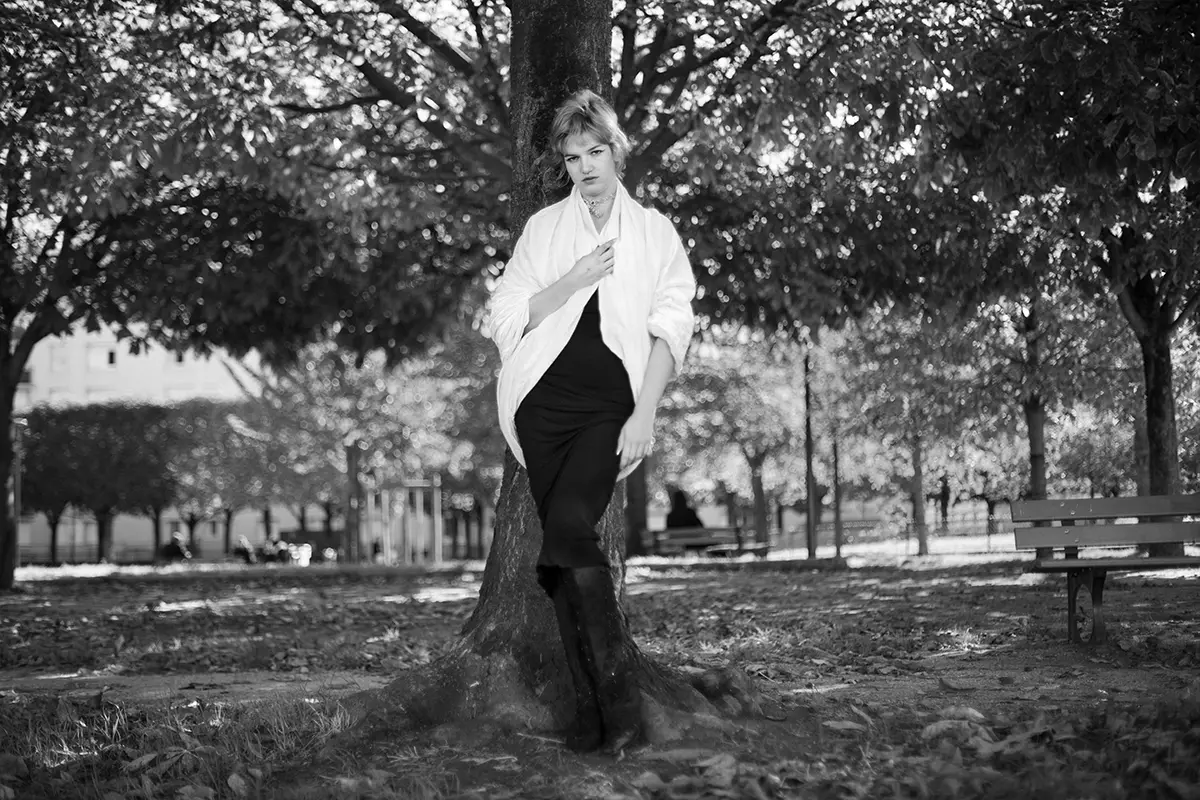Awarded the prize for best actress for her interpretation of an intersex character in the series About Sasha, Angèle Metzger made her first ceramic show in Paris, presenting daggers with sleeping faces
French actress and ceramic artist Angèle Metzger, defies easy categorization. On the rise, the young woman discusses how her journey has consistently woven together theoretical reflection and creative practice. After dedicating several years in learning and philosophizing about gender’s fluidity and its metamorphosis, she acted the role of an intersex character in the rewarded series About Sasha.
Studying art philosophy at La Sorbonne: from theory to practice
It is on the bench of the Parisian institution La Sorbonne that Angèle Metzger studied philosophy and art history before specializing in the intricacies of gender theory and gender fluidity. Amid her diverse subjects of study, she explored the concept of transgression in cross-dressing by examining artistic self-portraits. In the midst of one course, she was tasked with composing an essay about a plastic photographic artist but secretly opted to invent someone.
Selecting a pseudonym anagramming her own name and not disclosing her fabricated persona’s gender or identity, Metzger explored how information about an artist can shape the perception of their body of work. The fictitious artist then became the focus of her thesis, which delved into the transformation of the concept of gender and its depictions. But this imaginary artist needed to have a body of work. As the idea of creating the artists’ art pieces slowly began to take shape, Metzger headed to the ceramic studio where she had taken courses as a child.
Dreams and trickery: the birth of Angèle Metzger’s artistic practice
«All year long I had this drive to create something myself, but it all really started when I woke up from a vivid dream where I was sculpting a face from clay», explains the young woman before saying, «it had a huge impact on me. I really felt like I had done it, and above all, I was sure I could do it again». This face she had envisioned from her dream had closed eyes, rosy cheeks and prominent horns. Determined, she went to the studio and although it took her several weeks, the initial attempts being somewhat clumsy, she eventually succeeded. She then employed the medium of plastic photography, incorporating clay beneath, as a means to redefine the portrayal of the female sexual organ.
«The concept was to restore form to the female sex and transcend its conventional flat perception», explains the young artist citing French philosopher Luce Irigaray. After numerous trials and errors, she had produced a sufficient number of pieces to convince her instructors of the artist’s existence, eventually making it the focal point of her diploma thesis.
Androgyny and Cinema: an introduction to acting
Metzger’s fascination was piqued when she studied a portrait of a young child, taken by the American photographer Dorothea Lange, in which the child’s gender could not be definitely ascertained. Slowly, the notion of androgyny and Human’s fluidity surfaced everywhere in Metzger’s life. At the moment the fashion and cinema industries had become increasingly obsessed by this emerging norm of androgynous beauty. Even though she did not find herself looking very much androgynous, the young woman found herself receiving a lot of casting opportunities for it.
«My mother has quite an androgynous physique, and she dreamt of becoming a comedian. But she faced challenges in landing roles because she was considered too tall, her voice was too deep, or had short hair. It appears that I came during an era when casting directors were seeking a broader range of female characters, ones that didn’t necessarily conform to the traditional standards of beauty», explains Metzger.
Stars by the Pound and About Sasha: Some breakthrough inclusive roles
For her breakthrough role, in the 2019 film of Marie Sophie Chambon Stars by the Pound, she end-up portraying an anorexic teenager with short hair who struggled to accept her evolving femininity. Followed an offer to star as the lead character in the TV show of Yael Langmann and Jeremy Mainguy About Sasha. She playedan intersex young woman who had identified as a boy until the previous summer and was given a year to explore her identity before deciding whether to undergo surgery.
«Yael Langmann, the creator of the series, has been and still is a truly inspiring figure for me with her unclassifiable way of existing in the world», explains the actrice. At first reluctant to portray an intersex character due to concerns about legitimacy Metzger embarked on an intense period of introspection and self-examination.
The series About Sasha: A practical examination of gender definition through an intersex character
At the time she also began reading French philosopher and feminist theorist Monique Wittig which explains that women have been counterfeited to such an extent that their physical appearance we call ‘nature’, is in fact the product of external alterations imposed upon them. Which is explaining, why for so many women the process of resembling that female image feels arduous and unnatural. The actrice started questioning her own perception: «I realized that I identified as a girl because it’s what I’ve always known, but I could potentially identify as a boy if I were to become accustomed to it». And so every day, she looked in the mirror while telling herself «I’m a man». She explains, «I was trying to trick my brain into thinking that the face it was seeing could have been that of a young man».
Her hesitancy concerning legitimacy in playing the role of an intersex character as a cisgender woman is it’s true a prevailing debate in the cinema industry, raising questions about the extent to which an actor can interpret characters and where the boundaries lie. But what ultimately led Metzger to embrace the role of Sasha was the inclusive approach taken during the casting process. A call was initially extended to an intersex association, although it garnered no participants, given that many preferred not to reveal their identities on television. The casting scope was then broadened to encompass less visible non-cis communities. Subsequently, the casting tapes were shared with The Collectif Intersex Activiste and its members evaluated the auditions without prior knowledge of the actors’ genders, and chose Metzger’s profile.
Returning to the ceramic studio: A first dagger with a sleeping face
Upon her return from the filming of the series About Sasha, for which she earned the Séries Mania and Le Film Français Revelation Award, Metzger enters the Studio des Arts Céramiques of Saint-Denis where she worked on expanding her practice. «Unlike my approach during my master’s degree, I chose to reverse the process. Not letting theory precede practice and instead diving in, without overthinking, putting my hands to work and letting the results unfold naturally». From that, emerged an intriguing creation: a sword adorned with a small sleeping face. «I was influenced by a billion thoughts that had traversed my mind, fuelled by a lot of imagination, yet it always seemed relatively mysterious», explains the artist, stating it might have been the current medieval aesthetic trend, the cartoons she watched as a child or her readings of the novel Les Guérillères by Monique Wittig that had inspired her creation.
When asked about the meanings hidden in those little half-human half-weapon creatures that she sculpt in ceramic, the young artist explains having created without a full comprehensive grasp of the why. But she got to find a posteriori explanation : their eyes are closed as looking at their inner world, burying a form of natural and inner violence that can’t be expressed in our modern world. «I sensed a latent violence within, one that I refrained from expressing. In a city like Paris, marked by constant aggression and hostility, I realized that depression often constitutes the harm we inflict upon ourselves», she said. These creations are also so fragile that using them in combat would shatter them, much like how a bee perishes upon stinging, later explains Metzger.
Dancing and performing: another string to Angèle Metzger’s bow
Angèle Metzger followed by undertaking other ceramic projects, though they either remained unfinished or shattered in the kiln. She played in Drone Game, a film made by Olivier Abbou which was released in October on Amazon Prime but it’s dancing and singing master classes that predominantly consumed her time. Like all the little girls of her generation, Metzger commenced by enrolling in classical dance lessons. From the age of five until her twenties, she eagerly prepared and performed for the annual end-of-year showcases that would happen in huge Parisian concert halls. With her bun pulled back tightly, some blush and lipstick, the young woman fondly remembers the backstage excitement, the jitters before stepping onto the stage, or being dazzled by the spotlight.
«This fantasy of the stage has always lingered within me. I’ve often thought that I might prefer doing theater over cinema. There’s something really incredible about live performances. The immediate connection with the audience, the rush of adrenaline, and this feeling of truly stepping out of your own skin», explains Metzger.
A diversity of practice: working on performance and creative movement
It was during a trip to Montreal with some friends that she discovered pole dancing at a club. Enthralled by the empowering performances she witnessed, she returned to Paris with a burning desire to delve into this new discipline.While pole dancing wasn’t widely recognized in France at the time, she faced challenges but eventually found a school, dedicating five years to honing her skills. «It had taken me such a long time, and at one point I thought I’d concentrate on that — doing experimental research for performance and creative movement—».
In June 2021, she took part in performance artist Paloma Vauthier’s Freak Show exhibition, an exploration of the relation between pole dancing and 20th-century freak shows, through moving images presented at the 104 in Paris. Clad in hair and sporting a fake bald head, Metzger transformed into an otherworldly character, delivering a performance that defied all conventional expectations of pole dancing. Her contemporary dance style saw her gracefully maneuvering around and up the pole challenging the onlookers by the odd contrast prevailing in this video piece.
An Italian journey and a first solo ceramic exhibition
Weary from the city’s hustle and craving for a breath of fresh inspiration, the young woman made the decision to embark on a solo journey to Italy. Her destination: the island of Stromboli in the Tyrrhenian Sea, just off the northern coast of Sicily. Having visited it a few months earlier during the filming of the movie Drone Game, she explains: «the energy was electrifying there, and I thought to myself, ‘I’m going to be supported and carried; because you’re never truly alone in a place like this». For a month and a half, she would travel the Aeolian Islands, getting immersed in the unique fantastic realm that exists in such otherworldly places.
«They possess their own rules, supernatural mythology, and alternative rituals and traditions that are ingrained in you as you grow up there», explains Metzger with a gleam in her eyes.There, she found the opportunity to step back and contemplate the events of the past few years. Allowing herself to establish connections between themes which often recurred in her practice — transvestism and transformation, the metamorphosis of genres or the mixing of different artistic mediums. But it’s when visiting the island of Lipari’s Archaeological Museum that the concept of her first ceramic exhibition «Un jour je saurais couper les tornades» [Someday I’ll know how to cut tornadoes] came to life. In the museum’s display cases, hundreds of small blades crafted from obsidian, a lustrous volcanic stone with a deep black hue found on the island, caught her attention.
Returning to ceramic studio and creating a cabinet of curiosities curation
As she had already made one ceramic dagger, on her return from Italy, she went back to the Studio of ceramic art of Saint-Denis and inspired by the aesthetic of what she had seen in Italy, created numerous small knives adorned with black blades and slumbering faces. And for the curation of the exhibition, she immediately thought of creating a sterile ambiance, akin to a laboratory, a cabinet of curiosities or that museum she had just visited.
On the 9th of June, she presented within the confines of the gallery Untitled, her art works as they had just been discovered and neatly arranged on white walls or within drawers. She intentionally preserved numerous fragmented pieces, as they resembled uncovered artifacts found in the sea or during archaeological excavations. «I love the hyper-methodical collector aspect to these fragments — such as plant or butterfly collections – which are destined to fade away, but there is the unyielding human desire to conserve and scrutinize. Perhaps it’s the inherent fragility of the scientist’s nature», explains the artist.
Looking forward: a next exhibition inspired by the aesthetics of Palermo’s catacombs
Currently on set for the movie Porcheville of Marcia Romano and Benoît Sabatier in Marseille, Angèle Metzger will soon return to Italy for Hotel Atlantico, an art residency in Tuscany made by poet and singer Sarah Descisciolo, where she will craft the pieces constituting her second solo exhibition.
Inspired by her visit to Palermo’s catacombs, where small skeletons dressed in elaborate attire are adorning the walls, she decided to partially cover her next sculptures with fabrics. These hand-sized characters with closed eyes would each be enveloped in very fine fabrics, resembling chrysalises, through which their forms would be partially discernible. Letting it for the spectator to wonder whether they are asleep, dead or undergoing some form of metamorphosis.
A immersive curation and a forecast first solo performance
Gathered under one single installation piece, her next pieces which she has already begun working on, will adorn every wall of a room, which she envisioned as the natural habitat for her creatures. Not planning for it to happen in typical whitewall gallery space, she explains, «you’d step into a space with an enigmatic identity, akin to a catacomb, a dormitory, or a chapel. The installation would thus play with notions of death but also childhood — the figures reminiscent of swaddled infants—, or slumber».
A space she imagined open for a limited duration, perhaps accessible through a ritual or a dinner that would invite spectators to become part of this world. She adds, «There might even be a performance that imparts the installation with power and theatrical allures». In the meantime, the young woman will keep on doing what she does best, traveling, contemplating, thinking, and creating through every single medium her body provides while reinventing Angèle Metzger at each stage of the journey.


